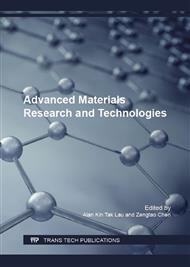p.104
p.109
p.114
p.122
p.127
p.132
p.137
p.142
p.149
The Effect of Tool Orientation to Cut Geometry in Five-Axis Milling Using Analytical Boundary Simulation
Abstract:
One of the characteristics of five-axis milling is the tool can be oriented in any direction. It makes the tool orientation could be changed continuously during a free-form machining process. Consequently, the work to predict Cutter Workpiece Engagement (CWE) become more challenging. The existence of tool inclination angle and screw angle influence the profile of cut geometry. In this paper, an improved method to define the lower engagement point (LE-point) is presented. The algorithm was developed by taken into consideration the existence of inclination angle and screw angle. The extended method to calculate grazing point in swept envelope development was utilized to define LE-point. The developed model was successfully implemented to generate CWE data with various combination of tool orientation angle. From the test it was found that inclination angle gives significant effect to the location of LE-point.
Info:
Periodical:
Pages:
149-153
Citation:
Online since:
November 2016
Authors:
Price:
Сopyright:
© 2017 Trans Tech Publications Ltd. All Rights Reserved
Share:
Citation:


